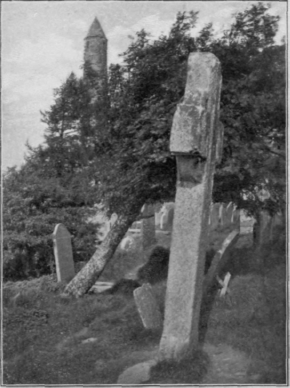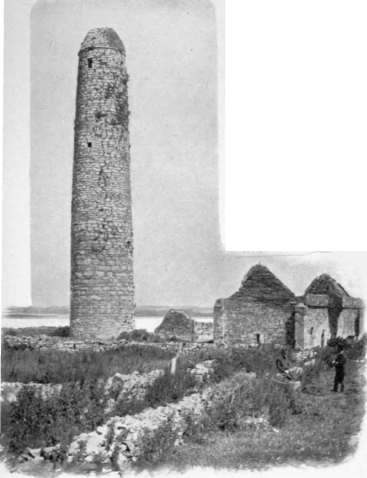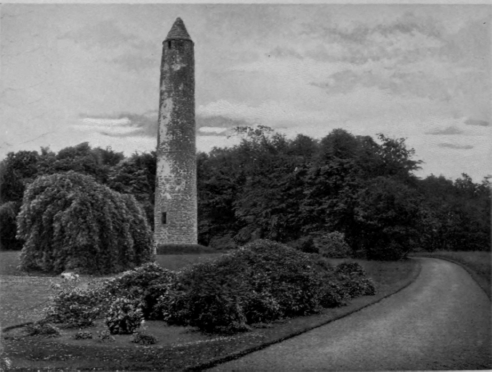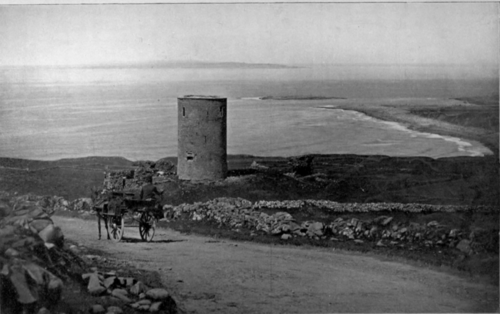Ireland. Part 29
Description
This section is from the book "Ireland - John L. Stoddard's Lectures", by John L. Stoddard. Also available from Amazon: John L. Stoddard's Lectures 13 Volume Set.
Ireland. Part 29

Tower And Cross, Glendalough.

Round Tower, Scattery Island.

Ruins On Holy Island, Lough Derg.

Round Tower, Antrim.
These two forms, minaret and tower, seem almost emblematic of the religions which they serve. The work of Islam is artistic and poetical, like the gifted race that gave it to the world. The storm-defying, unembellished tower of the Irish Church is typical of the stern, ascetic faith which there prevailed. These lonely monuments of Erin are now silent. No silver-throated bells sound from their summits either notes of warning or calls to holy rites. Their slender shadows make a daily circuit rarely broken by a sign of life. What thoughts they stir in one who watches them in idle reverie, as their thin silhouettes lengthen through a summer afternoon ! What tragedies have been enacted within them, and without! For, if it be true that there is hardly a hill or valley in Ireland that has not echoed to the sounds of early Christian prayer and praise, it is, alas, equally true that there is hardly one that has not been made tragic by the life-story of this hapless people; hardly a brook or river that has not been crimsoned with their blood. What manner of men were they who reared these lofty belfries? Whence came they? Whither did they go? Their dust has probably been resurrected in leaf and bud and bloom many a time since their hands placed these stones in their ascending curves. But where are the restless souls that once sought peace and pardon in their shadow? Are they mourning for the sorrows and sins of Ireland in the moaning of the wind, wandering through these empty chambers? Is it their unseen feet that lightly bend the heads of yonder ferns and flowers? Have they inscribed a message on the leaves that tremble on their stems, and then drift down to earth to lie unheeded? And when the tempest tosses the bare branches of the trees, is it the same old struggle carried into the spirit life, - the conflict between priest and pagan, the old faith and the new? The spirits cannot tell us, for their tongue is strange; and, were there really messages to read and hear, who could translate to us their meaning? Such thoughts will doubtless seem too fanciful to any one who reads these words outside of Ireland; but I am writing them where poetry, paganism and mythology still exercise a potent charm. It is a land of beauty, mystery and grandeur, encompassed by a shifting pageantry of sea and sky; a land of ruined castles, weirdly solemn mountains, lonely rivers and innumerable lakes, surrounded by a vast expanse of tossing waves. Beyond its cavernous cliffs and giant headlands lies the ocean, stretching away apparently to the edge of the world, over which daily, century after century, the islanders have watched the sun plunge into an abyss of waters as mysterious as the grave, propounding in its glorious exit the perpetual enigma, Whence and Whither? These influences have combined to make the popular faith of Ireland tend to a spirit-haunted universe, and give to the entire island even now a subtle fascination easy to feel, but difficult to explain.

Where The Ivy Climbs, At Swords.

A Bit Of Galway Bay.

Round Tower, Armoy.
"The pillar towers of Ireland, how wondrously they stand By the lakes and rushing rivers, through the valleys of our land; In mystic file, through the isle, they lift their heads sublime, Those gray old pillar temples, those conquerors of time !"

" A Shifting Pageantry Of Sea And Sky," Dunluce Castle.

" Whence And Whither?"
But Ireland has other monumental features, as characteristic of the past as are its Round Towers. Not many years ago there appeared in the cemeteries of America a new style of mortuary memorial, - a finely ornamented cross, with arms united to the shaft, above and below, by a circle. It was called the Celtic cross; and though I supposed from this that it had originated in Ireland, I had formed no idea, before I travelled there, how rich the island is in such mementos of the early faith. No less than forty-five of Erin's ancient crosses still remain, some of which reach a height of twenty-seven feet, and are adorned with sculptured ornamentation. Some also bear the names of Irish kings or abbots of the tenth and eleventh centuries. I felt anew, in looking at them, how great was the religious fervor of that Golden Age of Ireland. Whether her monks reared lofty watch-towers, erected churches, fashioned jeweled chalices, or carved elaborate crosses, they worked with an enthusiasm and devotion rarely equaled. No doubt they labored thus with an implicit faith, not only in personal immortality, but in a speedy termination of the world's existing system, and the inauguration of another. Yet these stone figures are as carefully carved as if they were to last till time should be no more. In fact, the story of the Cross meant far too much for even the slightest detail in the treatment of the theme to be neglected. To fashion and embellish one of these majestic crosses no effort was too great, and no device too intricate. Even when it was intended to be merely an ornament, the sculptor felt that it would stand within God's Temple, its arms outstretched beneath the dome of heaven, with the sun, moon and stars for altar-lights, and guarded by angelic hosts; and when it was designed as the memento of some sainted soul, no doubt the artist hoped his faithful labor would be both recognized and rewarded by the reminiscent and appreciative dead. How comforting must have been this simple faith to those who worked on bravely, though their primitive tools could not respond to their ideals!
Continue to:


